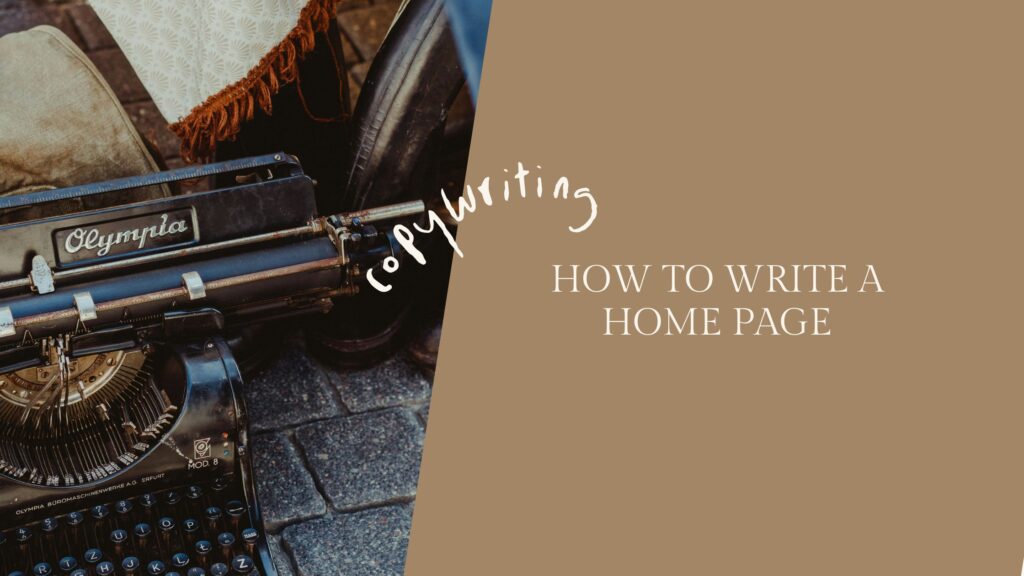Website copywriting tips: Home page
If you’re anything like those who love my digital product shop, you want to learn how to write copy that converts readers into buyers from the moment they land on your business’ website. And you want to be able to write your website copy fast. You have better things you’d rather be doing, right? And while every page of your website copy has its challenges, you may be stuck wondering how to write a home page that best describes everything you do.
Because you do a f*cking lot. And how can you possibly cut that down to fit in the few canvas provided in the website template you just bought?
I get it. I’ve been there as a baby website copywriter too. But now, I know a few things.
Hey, I’m Jill Wise, your resident website copywriter reporting for duty 👋 with the top tips you need to DIY your home page copy today.
And if you read this post, but ultimately decide you want help writing your copy from a website copywriter, I have both done-with-you and done-for-you website copywriting options. Learn more about booking an Intensive or what I can do for you in my Studio.

Website copywriting is kind of my thing
I’ve written more websites than I can count over my decade of freelancing (at the time of updating this blog post… wtf I’m not even that old?!). Each one obviously needs a home page too. So, yes, I’m blasting my own damn horn when I say I can answer all of your questions about how to write a home page for your business’ website.
Seriously, ask me anything. Or grab my Website Copy Template Library from The Biz Bar. Or learn more about working together. I’d love to help.
Back to the point though… Here’s my best SparkNotes style advice on how to write a home page for your business’ website.
Step 1 of how to write a home page for your business
When you’re stuck with any business challenge, first remember the goal: How would it change your life to have new leads in your inbox every week because someone found your website and they can’t wait to work with you? Speaking from experience of building that automated pipeline of inbound leads… It’s great.
Most people think that writing their about me page copy is the hardest task to tackle. It’s difficult to write about yourself—right? Yes, but it’s even more challenging to summarize what you offer in a space as small as a homepage.
What’s the most important thing to say?
What lead magnet should you include?
What offers deserve home page real estate?
Take a step back, breathe, and remember the goal: Your website copywriting should automate the qualification process of inbound leads for you. And often, it starts with them landing on your homepage.

Good website copywriting has a clear message and CTA
To add more challenges to the mix, you need to consider that while another page, like your about me page or services page, has just 1 clear call to action (therefore a distinct flow through the copy) your homepage is multi-purpose.
Aka, you can say more sh*t on your homepage and it won’t confuse people because that’s it’s job: To direct traffic.
But if you’re not a website copywriter by trade, or you’re just getting started as a website copywriter, the extra leeway for more CTAs on your home page copy might leave you stressed.
How do you condense all of your products, services, or skills to a summary that is both informative and interesting? Quick and snappy, yet all encompassing? And directs readers to the exact inner page they need to go to continue on the seamless buying journey?
Queue the spiral.
Remember, I got you.
What counts as a conversion for your home page?
Next, you need to know: What counts as a conversion? How do you convert someone on your home page? This is sort of a trick question because there’s more than one way to convert a reader on a home page. It just depends on what you count as a conversion.
A conversion could be:
Someone subscribes to your email list via your footer or the lead magnet on your home page.
Maybe they even purchase a product (cha ching!). But honestly, that’s unlikely if they just land on your homepage, aren’t familiar with you, and don’t go anywhere else first.
The point is that given the nature of home page copywriting, you could have multiple conversion measurements.

How to write a home page despite the “Rule of 1”
As the long-time queen of copywriting, Joanna Wiebe tells her audience time and again on her podcast, writing copy that converts is a combination of art and science. She teaches the “rule of one.” That means writing each landing page on your website for 1 reader, using 1 message, including 1 offer, and 1 promise. This theory is common throughout website copywriters, but I like how she teaches it.
With a homepage, however, this rule is impossible to follow for a couple reasons. First, it’s impossible to know what stage of the buying process that your homepage reader is at. Did they accidentally stumble across your blog or are they searching for someone like you? Maybe they are familiar with your work and nearly ready to buy. Second, your homepage has multiple roles to fulfill as it welcomes people to your website, so you need to check every box.
The key to writing a killer home page that keeps clients clicking through to your contact information is to swiftly direct them to exactly where they need to go. Unlike other pages, like your blog or sales page, you don’t want them to linger.
10 must-dos (instead of Googling how to write a home page more)
What actually goes on your home page copy? This differs depending on the type of business, but if you’re a creative entrepreneur for example, the following items should be included on the home page of your website…
- A banner image and headline that catches the reader’s attention. Try to identify them with this first headline.
- A sub-headline that introduces the solution you offer.
- A brief overview of what you offer and what makes you unique.
- Potentially a short founder summary.
- Direct the reader to your service offerings based on the type or delivery method if you offer multiple.
- Your latest lead magnet or promotion. This can be a banner that changes as your offers change.
- Featured or latest blog posts or social media feeds to further engage the reader.
- If you don’t include a lead magnet, at least add your email subscription form.
- The strongest testimonial you have that supports the copy.
- Beautiful imagery and visual branding that appeals to your target clients.
Always always always focus on quality over quantity when writing website copy! Edit thoroughly and harshly to cut anything that is redundant. Get to the point as quickly as possible. You don’t want to bore potential clients with flowery language that they can’t connect with.
Step-by-step of how to write a home page for your website
Now let’s talk about the overall process of how to write a home page. Everyone has a different workflow, but here’s an overview of mine. This is legit the process I follow as a website copywriter, for my own website and for clients through my agency.
1. Create a detailed outline of the page as part of your bigger website strategy.
You need the big picture here. For that reason, my website strategy briefs always include page-by-page breakdowns of everything I want to say. The core message, each canvas or section, CTAs… that kind of thing.
You need to start with an outline. A lot of people experience writer’s block because they don’t know where to start. Think of the essays you had to write in school. If you created a detailed outline first, then writing was a lot easier. Paint by numbers, following your plan.
It’s the same thing when we have to write copy. Whether I’m writing for myself or my clients, I always spend phase 1 of the project researching and outlining the exact things that will at each stage, then start to write in phase 2 after I’m 100 percent happy with the outline. Taking the time to do this first actually sometimes takes longer than writing the copy itself because I’m so detailed about what goes where!
This is where I think it’s important to note that copywriting is just as much science as art. Your shitty first draft doesn’t need to be any more than that… Shitty. So many people expect perfection from the first iteration, when the creativity can come later. First, get words on the page that check the boxes on your outline.
2. Speak directly to your ideal client when you’re writing.
The biggest rule of copywriting is that you need to speak directly to your ideal client and you need to speak their language. Meet them where they are, show them that you know them, and let them know that you are there to help. Sales requires a mindset of service, and serving others starts when you take the time to learn about them. It will give them the warm fuzzies because they feel seen and heard, and you’ll increase your conversion rates.
This is why brand messaging guides are a mandatory step in my full-service projects. If you don’t have one that’s comprehensive enough, we need to start here. I even recommend that DIYers consider building a brand messaging guide for themselves, so they know who they are and what they want to say, and who they’re talking to.
This is also why message research is so important. You can’t truly know who you’re talking to without talking to them. 🤯
When introducing yourself, make it all about the reader still. Who are you, but why does that matter for them? What information is relevant for them to know? What problem do you solve for your ideal client? Why are you the best person for the job?
3. Maintain the goal of directing traffic, and know where they’re going.
I’m not a fan of the long-form home pages that read more like sales pages. Keep that sh*t for your sales page, please. The purpose of a home page is to qualify and direct traffic, not get into the meat of your pitch.
Don’t overwhelm them from the start. Confused people don’t buy, so you need to make this process super simple for them. Map out their journey through the home page and into the rest of your business’ website. I include this flow or map as part of my website strategy briefs.
4. Write first, edit later.
Don’t let yourself get stuck with website copywriting. Just write now (keeping your outline and strategy in mind) and edit later.
I often will review a website strategy brief first thing the day I’m writing website copy. I’ll add any key notes to my empty Google Doc, then close that document and write as it comes to me.
Later, when editing, I’ll have both documents open side-by-side to make sure I’ve hit every strategic point.
5. Take the time to edit before publishing.
Please please please do not publish your new website copy without editing it first! If you’re not capable, hire a website copywriter to help you. Or at least have a friend look it over quickly.
Your home page could be the first time someone meets you on the internet. Make a good first impression.
Pro tip of how to write website copy: Keep it brief.
Your home page copy is not the place for your life’s story. Stick to the point within each section of the page and get there as fast as possible without sacrificing clarity. People are busy these days, and we need to be aware of that if we want them to stick around.
Website copywriting for creative businesses
Website copywriting follows similar rules and trends for all types of businesses, but creative solopreneurs, personal brands, freelancers, and course creators are some of my favourite to work with because we get the flexibility to have fun with our website copy.
Look at mine, for example. I know my website copy doesn’t always vibe with corporate types, despite the work I’ve done with large-scale corporate companies and those within similar industries.
Website copywriting for creative businesses can be human. We get to all be human beings behind these screens! I think that’s why I love my job so much… I get to help real people make more money online.
Read this if you’re still struggling with how to write your homepage copy…
Cool. That’s what I’m here for. Really—if it were easy, I wouldn’t have a job. So if you want to DIY your website copy, but need more help figuring out what the heck to actually say, check out the website copy templates in The Biz Bar. These plug-in website copy templates are wireframed as well, so you not only know what to say, but where to say it. Design falls into place easily around it.
But you should honestly go grab yourself a website design template too. Make it all easier for yourself.
Work smarter, not harder. Right?
Cheering you on.
Get additional support from a website copywriter
If we haven’t met yet, I’m Jill Wise. 👋 Brand and marketing strategist, and conversion copywriter. Here’s support options if you’re looking for a website copywriter.
Book an Intensive with me to strategize or optimize your website copy: Intensive days are the fast-track for newer creators, service-providers, and business owners who need done-with-you copywriting and strategy support ASAP. I wear either my business strategy, sales funnel strategist, or website copywriter hat as you need. Learn more here.
Hire me for a full service website copywriting project. In the Studio, we do brand messaging and website copywriting for rule defying founders. My approach combines traditional copywriting tactics with your unique personality to actually connect with and engage your ideal clients. Brand messaging and website copywriting is often the entry point for new clients. From there, we can grow into email marketing and other business growth channels. Learn more here.
After your website is live you may want to start an email list. You can write consistent, engaging emails to your list with help from the Newsletter Prompt Pack for 52 copywriting prompts so you can write emails to subscribers every week in 30 minutes or less.
Take advantage of actionable tools inside The Biz Bar: Marketing, copywriting, and business-building resources and training to help you fast-track growth. Browse The Biz Bar.

Related
Leave a Reply Cancel reply
Leave your info below to join. You'll be added to my email list, but can opt out at any time.
